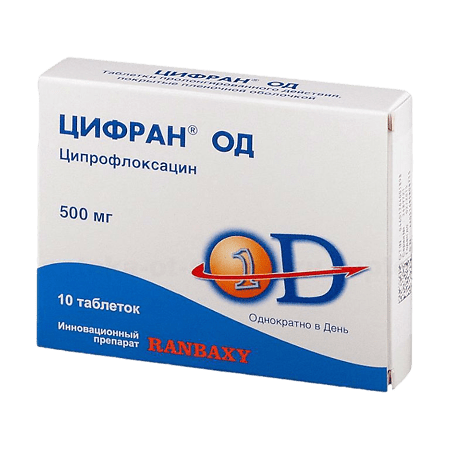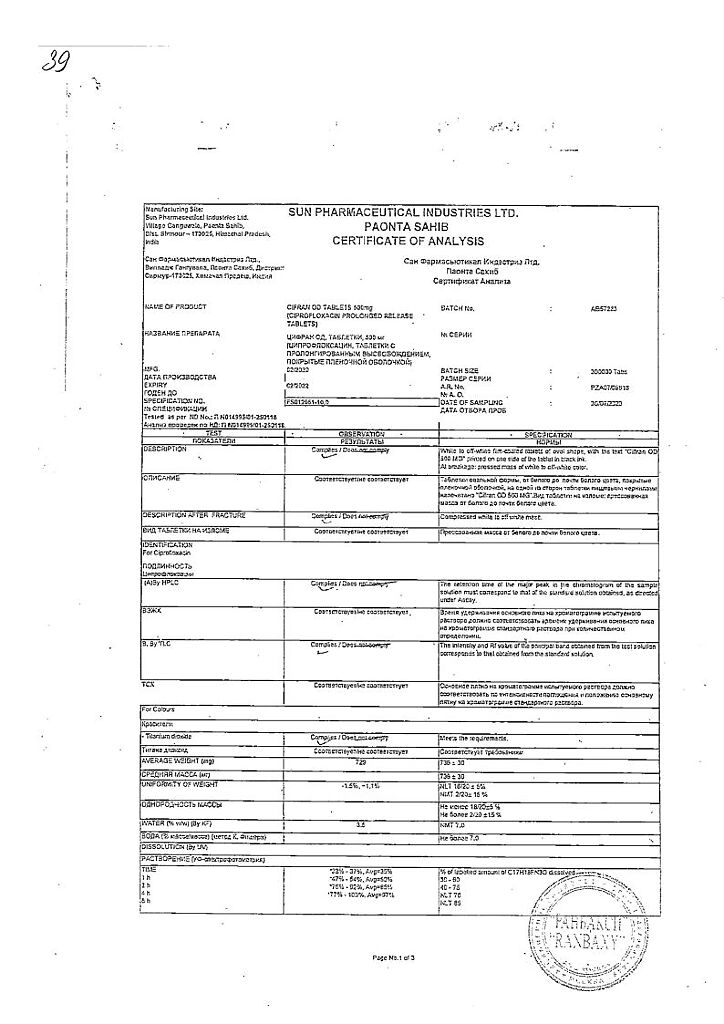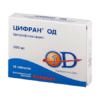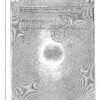No products in the cart.
Cifran OD, 500 mg 10 pcs
€5.96 €5.22
Description
A broad-spectrum antimicrobial agent of the group of fluoroquinolones. It has a bactericidal effect. Inhibits DNA-GiRase and inhibits the synthesis of bacterial DNA.
Highly active against most gram-negative bacteria: Pseudomonas aeruginosa, Haemophilus influenzae, Escherichia coli, Shigella spp., Salmonella spp., Neisseria meningitidis, Neisseria gonorrhoeae.
Active against Staphylococcus spp. (including penicillinase producing and non-producing strains, methicillin-resistant strains), some strains of Enterococcus spp., Campylobacter spp., Legionella spp., Mycoplasma spp., Chlamydia spp., Mycobacterium spp.
Ciprofloxacin is active against bacteria producing beta-lactamases.
Ureaplasma urealyticum, Clostridium difficile, Nocardia asteroides are resistant to ciprofloxacin. Its action against Treponema pallidum has not been studied sufficiently.
Indications
Indications
Cifran® OD is indicated for the treatment of the following infectious and inflammatory diseases caused by sensitive microorganisms.
– acute sinusitis;
– infectious and inflammatory diseases of the lower respiratory tract, including pneumonia, exacerbation of chronic bronchitis and infectious complications of cystic fibrosis;
– pyelonephritis, cystitis (including complicated);
– chronic bacterial prostatitis;
– gonorrhea;
– intra-abdominal infections (including peritonitis, intra-abdominal abscesses, cholangitis, cholecystitis, gallbladder empyema) is used in combination with metronidazole
– infectious diseases of the skin;
– infectious diseases of bones and joints (including acute and chronic osteomyelitis);
– diarrhea of infectious origin – incl. “travelers’ diarrhea”;
– typhoid fever;
– anthrax.
Pharmacological effect
Pharmacological effect
Broad-spectrum antimicrobial agent of the fluoroquinolone group. Has a bactericidal effect. Suppresses DNA gyrase and inhibits bacterial DNA synthesis.
Highly active against most gram-negative bacteria: Pseudomonas aeruginosa, Haemophilus influenzae, Escherichia coli, Shigella spp., Salmonella spp., Neisseria meningitidis, Neisseria gonorrhoeae.
Active against Staphylococcus spp. (including strains that produce and do not produce penicillinase, methicillin-resistant strains), some strains of Enterococcus spp., Campylobacter spp., Legionella spp., Mycoplasma spp., Chlamydia spp., Mycobacterium spp.
Ciprofloxacin is active against bacteria that produce beta-lactamases.
Ureaplasma urealyticum, Clostridium difficile, and Nocardia asteroides are resistant to ciprofloxacin. The effect against Treponema pallidum has not been sufficiently studied.
Special instructions
Special instructions
Photosensitivity reactions have been observed in some patients receiving fluoroquinolones. Excessive exposure to direct sunlight and UV radiation should be avoided. If a photosensitivity reaction occurs, it is recommended to stop using the drug. Since Cifran® OD is a drug with possible reversible toxic effects on the kidneys, it is not recommended for use in patients with impaired renal function, with creatinine clearance <29 ml/min, or in patients on hemodialysis or peritoneal dialysis.
When using almost all antimicrobial drugs, including Cifran® OD, the development of pseudomembranous colitis is possible, varying in severity from mild to life-threatening. If severe and prolonged diarrhea occurs during or after treatment, the diagnosis of pseudomembranous colitis should be excluded, which requires immediate discontinuation of the drug and the appointment of appropriate treatment.
To avoid the development of crystalluria, it is unacceptable to exceed the recommended daily dose; it is also necessary to have sufficient fluid intake and maintain an acidic urine reaction.
For patients with epilepsy, a history of seizures, vascular diseases and organic brain lesions, due to the threat of adverse reactions from the central nervous system, Cifran® OD should be prescribed only for “life-saving” indications.
If pain appears in the tendons or when the first signs of tendovarinitis appear, treatment should be stopped (isolated cases of inflammation and even tendon rupture during treatment with fluoroquinolones have been described).
During treatment, you should refrain from engaging in potentially hazardous activities that require increased attention and speed of mental and motor reactions.
Active ingredient
Active ingredient
Ciprofloxacin
Composition
Composition
Active substance:
ciprofloxacin – 500 mg.
Excipients:
sodium alginate (Keltone LVCR),
hypromellose,
sodium bicarbonate,
crospovidone (CLM),
magnesium stearate,
colloidal silicon dioxide (200),
talc.
Film casing:
opadry white 31B58910*, talc, hypromellose, purified water, black ink for writing (Opacode-S-l-17823 black).
Pregnancy
Pregnancy
Cifran® OD is not recommended for use during pregnancy.
Ciprofloxacin is excreted into breast milk, therefore, during lactation, if the use of Cifran® OD is necessary, then, based on the degree of importance of its use for the mother, you should decide whether to stop taking the drug or breastfeeding.
Contraindications
Contraindications
– pseudomembranous colitis;
– age up to 18 years;
– pregnancy;
– lactation period;
– hypersensitivity to ciprofloxacin or other drugs from the fluoroquinolone group;
– simultaneous use of tizanidine (risk of a pronounced decrease in blood pressure, drowsiness);
– chronic renal failure (creatinine clearance less than 29 ml/min, including patients on hemodialysis).
With caution:
– severe atherosclerosis of cerebral vessels; cerebrovascular accident; mental illness;
– epilepsy;
– renal failure (creatinine clearance 35-50 ml/min);
– severe liver failure, old age;
– Tendon damage due to previous treatment with fluoroquinolones.
Side Effects
Side Effects
From the digestive system: nausea, vomiting, diarrhea, abdominal pain, flatulence, anorexia, cholestatic jaundice (especially in patients with previous liver diseases), hepatitis, hepatonecrosis.
From the nervous system: dizziness, photophobia, insomnia, paresthesia, irritability, headache, increased fatigue, anxiety, tremor, “nightmare” dreams, peripheral paralgesia (anomaly in the perception of pain), increased intracranial pressure, confusion, depression, hallucinations, as well as other manifestations of psychotic reactions (occasionally progressing to states in which the patient can self-harm), migraine, fainting, cerebral artery thrombosis.
From the senses: disturbances of taste and smell, visual impairment (diplopia, changes in color vision), tinnitus, hearing loss.
From the cardiovascular system: tachycardia, heart rhythm disturbances, decreased blood pressure, “flushes” of blood to the skin of the face.
From the hematopoietic system: eosinophilia, leukopenia, granulocytopenia, anemia, thrombocytopenia, leukocytosis, thrombocytosis, hemolytic anemia.
Laboratory indicators: hypoprothrombinemia, increased activity of liver transaminases, hypercreatininemia, hyperbilirubinemia, hyperglycemia, increased activity of alkaline phosphatase and lactate dehydrogenase.
From the urinary system: hematuria, crystalluria (primarily with an alkaline urine reaction and low diuresis), acute interstitial nephritis (with the possible development of acute renal failure), glomerulonephritis, dysuria, polyuria, urinary retention, albuminuria, urethral bleeding, decreased nitrogen excretory function of the kidneys.
Allergic reactions: skin itching, urticaria, blistering accompanied by bleeding and the appearance of small nodules that form scabs, drug fever, pinpoint hemorrhages on the skin (petechiae), swelling of the face or larynx, shortness of breath, vasculitis, erythema nodosum, erythema multiforme exudative, erythema maligna exudative (syndrome). Stevens-Johnson), toxic epidermal necrolysis (Lyell’s syndrome).
From the musculoskeletal system: arthralgia, arthritis, tenosynovitis, tendon ruptures, myalgia.
Other: increased sweating, photosensitivity, general weakness, superinfections (candidiasis, pseudomembranous colitis).
Interaction
Interaction
Due to inhibition of microsomal enzymes in the liver, it increases the concentration and prolongs T1/2 of theophylline and other xanthines (for example, caffeine), oral hypoglycemic drugs (for example, glibenclamide), indirect anticoagulants (for example, warfarin and its derivatives). If it is necessary to use them together with drugs of these groups, it is necessary to monitor the concentration of the drug in the blood and adjust the dosage regimen accordingly.
In the presence of antacids containing magnesium hydroxide or aluminum hydroxide, the absorption of ciprofloxacin is reduced. Thus, the simultaneous use of these drugs should be excluded. In such cases, ciprofloxacin should be taken either 1-2 hours before or 4 hours after taking these drugs. Didanosine reduces the absorption of ciprofloxacin. This is due to the formation of complexes with magnesium salts contained in didanosine preparations.
When used together with probenecid and other drugs that block tubular secretion, the renal excretion of ciprofloxacin decreases.
Metoclopramide accelerates the absorption of the drug, which leads to a decrease in the time it takes to reach its Cmax.
Co-administration of uricosuric drugs leads to a slower elimination (up to 50%) and an increase in plasma concentrations of ciprofloxacin.
When combined with other antimicrobial drugs (beta-lactam antibiotics, aminoglycosides, clindamycin, metronidazole), synergism is usually observed; can be successfully used in combination with azlocillin and ceftazidime for infections caused by Pseudomonas spp.; with mezlocillin, azlocillin and other beta-lactam antibiotics – for streptococcal infections; with isoxazolylpenicillins and vancomycin – for staphylococcal infections; with metronidazole and clindamycin – for anaerobic infections.
Ciprofloxacin enhances the nephrotoxic effect of cyclosporine. There is an increase in serum creatinine concentration. In such patients, it is necessary to monitor this indicator 2 times a week.
Concomitant use of tizanidine with ciprofloxacin, which is an inhibitor of the CYP1A2 isoenzyme, leads to a 10-fold increase in the AUC of tizanidine. The result of combined use may be a clinically significant and prolonged decrease in blood pressure, leading to drowsiness, dizziness, and inhibited psychomotor reactions.
In patients receiving therapy with ciprofloxacin and phenytoin, variability (decrease or increase) in the concentration of phenytoin in the blood plasma was noted.
Combined use with non-steroidal anti-inflammatory drugs (NSAIDs) increases the likelihood of side effects of ciprofloxacin on the central nervous system (risk of seizures).
Absorption of ciprofloxacin when administered orally decreases after cytotoxic therapy with antitumor and immunosuppressive drugs.
Overdose
Overdose
Possible reversible toxic effects on the kidneys;
There is no specific antidote, so it is necessary to induce vomiting or perform gastric lavage and carry out symptomatic therapy:
– take measures for adequate hydration of the body (infusion therapy);
– maintenance therapy.
Only small amounts of ciprofloxacin (<10%) can be removed by hemo- and peritoneal dialysis.
Storage conditions
Storage conditions
In a place protected from moisture, at a temperature not exceeding 25 °C
Shelf life
Shelf life
2 years
Manufacturer
Manufacturer
Sun Pharmaceutical Industries Ltd, India
Additional information
| Shelf life | 2 years |
|---|---|
| Conditions of storage | In a moisture-proof place, at a temperature not exceeding 25 °C |
| Manufacturer | Sun Pharmaceutical Industries Ltd, India |
| Medication form | sustained release tablets |
| Brand | Sun Pharmaceutical Industries Ltd |
Related products
Buy Cifran OD, 500 mg 10 pcs with delivery to USA, UK, Europe and over 120 other countries.




















